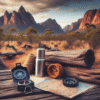Unleash Your Inner Explorer: Mastering Map and Compass for Campers
So, you’re thinking about ditching the GPS, huh? Or maybe you just want to feel a little more, well, competent when that battery inevitably dies five miles into the woods. I get it. There’s something incredibly satisfying about navigating with a map and compass – a connection to the land that a screen just can’t offer.
Why Bother with a Map and Compass?
Let’s be real: modern tech is amazing. But what happens when your phone’s dead, there’s no signal, or that fancy GPS watch decides to take an unscheduled vacation into a ravine? That’s when knowing how to read a map and use a compass becomes more than just a cool skill; it becomes essential to your safety.
Think of it this way: learning navigation is like learning to swim. You might not need it every day, but when you do need it, you really, REALLY need it. Plus, it’s empowering. You transform from someone reliant on technology into someone who can confidently explore, no matter what.
Understanding the Lay of the Land (Literally): Map Basics
Okay, so you’ve got this crinkly piece of paper – the map. It’s not just a random collection of lines and colors. It’s a carefully constructed representation of the terrain. Let’s break down the key elements:
- Scale: The relationship between distance on the map and distance on the ground. A scale of 1:24,000 means that one inch on the map equals 24,000 inches (or 2,000 feet) in the real world.
- Contour Lines: These are the squiggly lines that show elevation. The closer they are together, the steeper the terrain. When they’re far apart, it’s relatively flat. Imagine them as imaginary lines connecting points of equal height.
- Legend: Your map’s decoder ring. It tells you what all the symbols mean – trails, roads, campsites, water sources, etc. Don’t ignore it!
- North Arrow: This shows you which way is north (duh!), but here’s the kicker: there are actually *three* different norths we need to worry about! We’ll get to that magnetic declination headache in a bit.
See, maps aren’t just for figuring out where you are; they help you understand where you could go! Planning a route becomes its own adventure, imagining yourself traversing those valleys and cresting those ridges.
The Compass: More Than Just a Direction Pointer
Your compass is your trusty sidekick, your constant guide. It’s a deceptively simple tool with a lot going on under the hood. Here’s a look at the main parts:
- Baseplate: The clear plastic part that you hold in your hand. It has a straight edge for taking bearings.
- Magnetic Needle: The part that always points to magnetic north. (Remember that “magnetic declination” thing? Keep it in mind!)
- Rotating Bezel (or Azimuth Ring): This is the ring with the degree markings (0-360). You use it to set your bearing.
- Orienting Arrow: This little arrow helps you line up the compass with your map.
- Index Line: The fixed line on the baseplate that you read your bearing from.
Don’t be intimidated by all the jargon. Once you get your hands on a compass and start playing around with it, it’ll all start to click. Think of it as learning a new language; it’s weird at first, but soon you’ll be fluent!
Declination Demystified: Because North Isn’t Always North
Alright, let’s tackle declination. This is where things can get a little tricky, but trust me, you can handle it. Magnetic north (where your compass needle points) isn’t the same as true north (the geographic North Pole). The difference between the two is called declination, and it varies depending on where you are on the planet.
You know what? Sometimes, you can almost forget about declination on shorter trips. But get further into the wilderness, and it will become relevant when you are going longer distances.
So, how do you deal with it? Your map should tell you the declination for your area. (It’s usually printed right on the map.) Then, you either add or subtract the declination from your compass bearing, depending on whether it’s east or west declination. (Remember the saying: “East is least, west is best.” Meaning, subtract east declination and add west declination.)
I know, it sounds like a math class flashback, but it’s crucial for accurate navigation. Practice setting your declination adjustment on your compass before you head out. Most modern compasses have this feature.
Taking a Bearing: Step-by-Step
Okay, you understand the map and compass components. Now, let’s put it all together and learn how to take a bearing.
- Orient Your Map: Place your map on a flat surface. Use your compass to align the map so that north on the map points to north on the compass. This means rotating the map until the north arrow on the map is parallel to the north end of your compass needle (after accounting for declination, of course!).
- Locate Your Position and Destination: Find your current location on the map and the point you want to reach. Mark them clearly.
- Place the Compass: Lay the edge of your compass baseplate on the map so that it connects your current location and your destination.
- Rotate the Bezel: Rotate the compass bezel until the orienting arrow on the compass is aligned with north on the map. Make sure the “N” on the bezel is pointing towards the north end of the map. Again, this is where declination comes into play. Adjust accordingly!
- Follow the Bearing: Remove the compass from the map. Hold the compass flat in your hand. Rotate your body until the north end of the compass needle lines up with the orienting arrow inside the compass housing.
- Start Walking: The direction indicated by the direction-of-travel arrow on your compass is the bearing you need to follow. Pick a landmark in that direction and walk towards it. Repeat the process as needed, especially if the terrain is uneven or visibility is poor.
Following a Bearing in the Field: Staying on Course
Taking a bearing is one thing; following it accurately in the real world is another. Here are some tips to keep you on track:
So, you’ve got a bearing – great. But out in the woods? It’s not like there’s a giant arrow pointing the way. You’ve gotta be strategic.
- Choose Landmarks: Instead of staring at your compass the whole time (which can be disorienting), pick out a distant landmark that lies on your bearing. Walk to that landmark, then repeat the process.
- Account for Obstacles: If you encounter an obstacle (like a stream or a dense thicket), walk around it, but try to maintain your bearing as much as possible. Use your compass to compensate for any deviations.
- “Aiming Off”: This is a technique where you intentionally aim to one side of your target. For instance, if you’re heading for a trail junction, aiming off can help you know which direction to turn when you hit the trail.
- Back Bearings: To confirm you’re on the right track, take a back bearing (the reciprocal of your original bearing). If you’re heading east (90 degrees), your back bearing would be west (270 degrees). Looking back along your path should confirm that you’re heading in the opposite direction.
Orienteering Exercises for Improving Confidence
Practice makes perfect. The more you use your map and compass, the more comfortable you’ll become with them and the better you’ll be in the field. Why not play a little orienteering?
- Backyard Orienteering: Set up a simple course in your backyard or a local park. Hide markers and use your map and compass to find them.
- Geocaching: This is a real-world treasure hunt using GPS coordinates. It’s a fun way to practice your navigation skills and explore new places.
- Orienteering Clubs: Join a local orienteering club for organized events and training. You’ll learn from experienced navigators and meet other outdoor enthusiasts.
Camp Security: Integrating Navigation into Camp Safety
Camp security is a multifaceted issue. Knowing your surroundings is everything; navigation is the primary skill of awareness.
- Establish Boundaries: Map out the perimeter of your campsite and clearly mark boundaries, especially if camping with children.
- Emergency Exits: Identify multiple escape routes from your campsite in case of fire, wildlife encounters, or other emergencies.
- Compass Checks: Regularly check your compass bearing to nearby landmarks, ensuring you maintain directional awareness, especially during nighttime or inclement weather.
While advanced gadgets provide digital support, traditional navigational skills remain crucial. Integrate visual markers with compass readings to solidify your campsite’s layout in both your mind and physical space. You can integrate trail markers too, to reinforce the habit of always paying attention to your surroundings.
Essential Gear: Quality Tools for Reliable Navigation
Now, let’s talk gear. You don’t need to spend a fortune, but investing in quality tools will make a big difference.
- Compass: invest in a reliable baseplate compass with adjustable declination. Suunto and Silva are both reputable brands. Consider models with features like luminous markings for nighttime navigation.
- Map: Choose a topographical map that covers the area you’ll be exploring. Waterproof maps are a good investment, especially in rainy climates. Consider bringing a backup map in case your primary map gets damaged or lost. You can find these at outdoor retailers or online. (Like, say, REI.)
- Pencil and Paper: For marking your map, taking notes, and calculating bearings. Mechanical pencils with fine leads are great for precision.
- Ruler or Protractor: Helpful for measuring distances and angles on your map.
- Whistle: An essential safety item for signaling for help in an emergency.
Survival Strategies: Navigating Under Pressure
Okay, let’s get real. What happens if you get lost? Don’t panic! (Easier said than done, I know.) Here are some survival strategies to keep in mind:
- S.T.O.P.: Stop, Think, Observe, Plan. Stay calm and assess the situation.
- Retrace Your Steps: If possible, backtrack to the last known location.
- Shelter: Build a temporary shelter to protect yourself from the elements.
- Signal: Use a whistle, mirror, or brightly colored clothing to signal for help.
- Stay Put: Unless you know exactly where you’re going, it’s often best to stay put and wait for rescue.
Remember, navigation isn’t just about knowing where you are; it’s about knowing how to get un-lost! Even with GPS, you should always have the base skills fresh.
Advanced Techniques: Taking Your Skills to the Next Level
So, you’ve mastered the basics. Now, let’s explore some advanced techniques to take your navigation skills to the next level:
- Using a GPS as a Backup: GPS devices can be a valuable tool, but don’t rely on them entirely. Use them in conjunction with your map and compass skills. Learn how to enter coordinates and create waypoints.
- Night Navigation: Navigating at night requires extra caution. Use a headlamp with a red light to preserve your night vision. Practice using your compass in the dark.
- Navigation in Poor Visibility: Fog, snow, and rain can make navigation challenging. Use your compass to stay on course and pay attention to subtle changes in the terrain.
- Route Finding: This involves choosing the best route based on terrain, elevation, and other factors. Develop your ability to “read” the landscape and anticipate challenges.
The Ethical Navigator: Leave No Trace and Respect the Land
As navigators, we have a responsibility to protect the environment and respect the land we explore. Practice Leave No Trace principles, such as packing out all trash, minimizing campfire impacts, and staying on established trails. Be mindful of wildlife and avoid disturbing their habitats.
Beyond environmental ethics, also consider cultural respect. If you are navigating in areas with cultural or historical significance, learn about the local customs and traditions. Respect private property and obtain permission before crossing it.
Resources for Continued Learning: Keep Honing Your Skills
The journey of learning navigation is ongoing. Here are some resources to help you continue honing your skills:
- Books: “Mountaineering: The Freedom of the Hills” is a classic reference guide. “Be Expert With Map and Compass” by Bjorn Kjellstrom is another excellent resource.
- Websites: Check out websites like Wilderness Awareness School
- Courses: Consider taking a wilderness navigation course from a reputable outdoor education organization.
- Practice, Practice, Practice: The best way to improve your navigation skills is to get out there and use them!
Final Thoughts: Embrace the Journey
Mastering map and compass skills is a rewarding journey that will enhance your outdoor adventures and boost your confidence. It’s about more than just knowing where you are; it’s about connecting with the land and developing a deeper understanding of the natural world. So, grab a map, a compass, and get out there!
Frequently Asked Questions
<div class="faq-container">
<div class="faq-question">
<strong>How often should I practice my map and compass skills?</strong>
</div>
<div class="faq-answer">
Ideally, practice regularly! Even short sessions in a local park can keep your skills sharp. The more you use them, the more intuitive they'll become.
</div>
</div>
<div class="faq-container">
<div class="faq-question">
<strong>What if my compass doesn't have adjustable declination?</strong>
</div>
<div class="faq-answer">
No problem! You can still account for declination by manually adding or subtracting the declination angle when taking bearings. It just requires a little extra math.
</div>
</div>
<div class="faq-container">
<div class="faq-question">
<strong>Can I use my smartphone as a compass?</strong>
</div>
<div class="faq-answer">
Yes, smartphones have compass apps, but they're not as reliable as a dedicated compass. Batteries die, signals get lost, and the accuracy can be questionable. Use them as a backup, but always have a traditional compass.
</div>
</div>
<div class="faq-container">
<div class="faq-question">
<strong>Is it okay to rely solely on GPS for navigation?</strong>
</div>
<div class="faq-answer">
No! GPS is a great tool, but it's not foolproof. Always carry a map and compass and know how to use them. Technology can fail, but your skills won't.
</div>
</div>
<div class="faq-container">
<div class="faq-question">
<strong>What should I do if I get lost?</strong>
</div>
<div class="faq-answer">
Stay calm! Follow the S.T.O.P. acronym: Stop, Think, Observe, Plan. Retrace your steps if possible. If not, find shelter and signal for help.
</div>
</div>
<div class="faq-container">
<div class="faq-question">
<strong>How do I choose the right map for my trip?</strong>
</div>
<div class="faq-answer">
Select a topographical map that covers the area you'll be hiking in. Make sure the map is up-to-date and has a scale appropriate for your needs. Waterproof or water-resistant maps are a plus.
</div>
</div>DISCLAIMER
Navigating in the outdoors involves inherent risks. This article is for informational purposes only and does not substitute professional training or guidance. Always exercise caution, assess your skills and preparedness, and be aware of changing conditions. The author and publisher assume no liability for any injuries, losses, or damages resulting from the use of this information. Consult with experienced guides and local authorities before venturing into the backcountry.
Categories
- Navigation & Safety (33)
- Shelter & Sleep (34)
Recent Comments
Archives
Top rated products
-
 Camping Tent Canopy Zipper for 4-6 Person Outdoor Picnic Quick Open Awning With Chimney Waterproof Car Sun Shelter
Rated 5.00 out of 5$725.34
Camping Tent Canopy Zipper for 4-6 Person Outdoor Picnic Quick Open Awning With Chimney Waterproof Car Sun Shelter
Rated 5.00 out of 5$725.34 -
 BURCHDA AZ26 Adult Electric City Bike, Li-Ion Battery, 26 Inch3.0 Fatbike, 48V20AH, 1000W, 45KM/H
Rated 5.00 out of 5$4,131.46
BURCHDA AZ26 Adult Electric City Bike, Li-Ion Battery, 26 Inch3.0 Fatbike, 48V20AH, 1000W, 45KM/H
Rated 5.00 out of 5$4,131.46 -
 Naturehike 2025 New Camping Tent Ultralight Two Person Waterproof Large Canopy Tents Outdoor 4 Season 1 Person Travel Beach Tent
Rated 5.00 out of 5$690.71 – $690.92Price range: $690.71 through $690.92
Naturehike 2025 New Camping Tent Ultralight Two Person Waterproof Large Canopy Tents Outdoor 4 Season 1 Person Travel Beach Tent
Rated 5.00 out of 5$690.71 – $690.92Price range: $690.71 through $690.92
Product Gallery
-
 SUP water ski, double-layer paddle board, inflatable high-density EVA surfboard, anti slip pad
$134.94 – $154.77Price range: $134.94 through $154.77
SUP water ski, double-layer paddle board, inflatable high-density EVA surfboard, anti slip pad
$134.94 – $154.77Price range: $134.94 through $154.77
-
 In Stock inflatable sup boards paddleboards standup paddle board waterplay surfing Isup Surf board with standard accessories
$445.84 – $453.22Price range: $445.84 through $453.22
In Stock inflatable sup boards paddleboards standup paddle board waterplay surfing Isup Surf board with standard accessories
$445.84 – $453.22Price range: $445.84 through $453.22
-
 Spatium 2-3 Persons Inflatable Kayak Canoe High Strength DropStitch Floor Inflatable Kayak For Fishing
Rated 5.00 out of 5$2,114.27
Spatium 2-3 Persons Inflatable Kayak Canoe High Strength DropStitch Floor Inflatable Kayak For Fishing
Rated 5.00 out of 5$2,114.27


 Camping Gear
Camping Gear Camping Chair
Camping Chair Camping Table
Camping Table Sleeping Bags
Sleeping Bags Camping Bed
Camping Bed Sleeping Gear
Sleeping Gear Camping Trolley
Camping Trolley Storage Bags
Storage Bags BBQ Portable
BBQ Portable Camping Tents
Camping Tents Gazebos
Gazebos Outdoor Cooler
Outdoor Cooler Cookware
Cookware Power
Power Camping Light
Camping Light Flashlight
Flashlight Portable Solar
Portable Solar Power Banks
Power Banks
 Fish Finders
Fish Finders Fishing Bags
Fishing Bags Fishing Jerseys
Fishing Jerseys Fishing Reels
Fishing Reels Fishing Chairs
Fishing Chairs Fishing Bait Boat
Fishing Bait Boat Fishing Floats
Fishing Floats Hard Baits
Hard Baits
 Hiking Vests
Hiking Vests Outdoor Bags
Outdoor Bags Water Filters
Water Filters Paracord
Paracord Walkie Talkie
Walkie Talkie
 Paddleboards
Paddleboards Boats
Boats Sea Scooter
Sea Scooter Accessories
Accessories
 Electric Bike
Electric Bike Electric Scooter
Electric Scooter

















